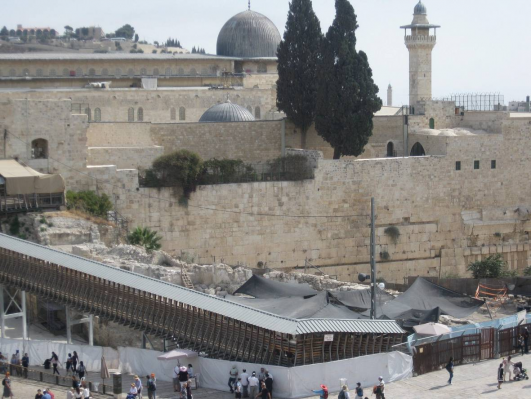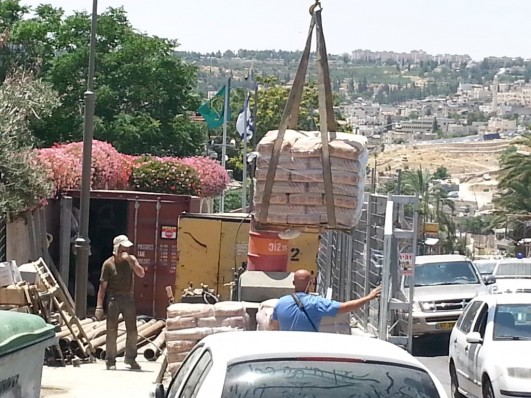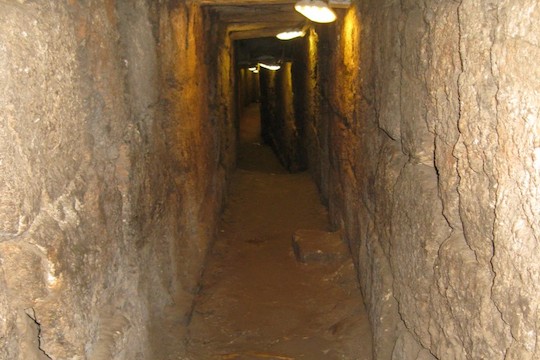Israel’s Very Own Tunnels of Dread in Jerusalem
PALESTINE - ISRAEL, 15 Sep 2014
The Tunnels Israel Doesn’t Want You Talking About
While everyone is preoccupied with the Hamas tunnels in Gaza, Israel continues to dig under Palestinian houses in Jerusalem. The excuses are questionable, residents are angry and fearful, and a religious conflagration appears imminent.
With the Hamas tunnels dominating the Israeli narrative for the past several weeks, their inherent danger horrifying the entire state and sometimes leading to apocalyptic visions, the state of Israel persistently continued digging its own underground tunnels – in Jerusalem.
These tunnels, like those of Hamas, are being dug under a heavy cloak of secrecy. As with the Hamas tunnels, they serve as a tool for resolving the Israeli-Palestinian conflict. They are also being dug under the houses of uninvolved civilians, in this case Palestinians. However, while the Hamas tunnels are described as serving terrorist purposes, these tunnels have been authorized by the Supreme Court of Israel, and all the relevant arms of the state have been mobilized in their support.
What follows is a conversation with archaeologist Yonatan Mizrahi from Emek Shaveh, an organization that focuses on the role of archaeology in the Israeli-Palestinian conflict, about what is going on underground in one of the world’s most volatile places, the historical heart of Jerusalem.
***
Is it correct to say that these underground excavations in Jerusalem, especially in the area of the Historic Basin, are not a new development?
Yes, that is correct. At the end of the 19th century and the beginning of the 20th centrury underground tunnels were dug as part of archaeological excavations. It was a method of excavation, for various reasons. Toward the beginning of the 20th century it became clear that this practice was very problematic as a research tool, and starting in the second decade of the 20th century the Silwan excavations reverted to an orderly method, from the top down, exposing strata, as we all know. Since that time archaeologists have no longer dug tunnels; it is no longer part of the modus operandi.
When was the digging of tunnels resumed?
After the state of Israel conquered the Old City of Jerusalem it introduced many changes, and in 1969 the Ministry of Religious Services began to carry out the excavations we know today as the tunnels of the Western Wall. The Department of Antiquities, what was previously the Antiquities Authority, was not really involved in these excavations. This was the situation at least until the year 2000. So begins the story of the tunnels of the Western Wall, which, with due respect, may perhaps begin at the Western Wall but they reach all the way to the Via Dolorosa, in the heart of the Muslim Quarter. These excavations are still going on. Then in 2005 the Antiquities Authority entered the picture as the body that effectively carries out the excavations. The Antiquities Authority also became involved in the excavations in Silwan starting in 2004. These excavations begin at the Pool of Siloam and ascend all the way to the Givati Parking Lot.
For a long time these excavations were conducted rather secretly, without revealing what was being excavated and where, and what the full plan was.
Correct. For years these excavations were conducted in secret, and there was a famous story of Yossi Beilin requesting to visit the site as a Knesset member and being told, “Definitely not, this is a private area.” Residents from the area tried to enter and were also refused.
What is being dug at present, as far as we can tell?
There is digging all the time. There are excavations carried out by the Elad foundation from the Pool of Siloam to Givati Parking Lot, and actually all the way to the Mughrabi Bridge. It is a never-ending project. The digging goes on all the time, in an attempt to enlarge the underground space.
And is this entire operation is supposed to come together at some point?
As we understand it, that’s the intention. See, they have already succeeded in connecting the excavations from Silwan to the Mughrabi Bridge. Essentially, only the space of the Western Wall Plaza has not been connected.
Can you explain who initiates such an excavation, who approves it and who carries it out?
Whoever attempts to initiate such a project, while appealing for a permit from the Antiquities Authority, is an entrepreneurial body that has an interest in the area. In the case of the tunnels, this is in fact the Elad foundation, which manages the City of David and the West Wall tunnels. Extending to the north is a project of the Western Wall Heritage Fund. These are two of the central bodies involved in excavations today.
The Antiquities Authority is a statutory entity, correct?
Absolutely, a statutory professional entity – or so it would seem. So, the Elad foundation appeals to the Antiquities Authority, and it decides to approve the excavations, which are, of course, financed by Elad. It’s a sort of contracting agreement. On the one hand, the Antiquities Authority has the power to decide whether to consent to Elad’s request but on the other hand, it is sort of held hostage by Elad, which provides the money. When the Antiquities Authority became involved in these excavations in 2004, in my understanding, it gave up its professional role, or it became almost irrelevant.
Professionally, the Antiquities Authority, which is familiar with the matter at hand, should not have approved these excavations at all. It should have opposed the digging of tunnels because this is no longer an acceptable archaeological practice, and has not been for a long time. That is to say, the Antiquities Authority relaxed its professional standards for the benefit of Elad, or the benefit of the of the State of Israel.
But the claim is that significant archaeological findings have been uncovered with the tunnels…
Well, I would like to tell you some things related to the Hamas tunnels. I think that the tunnels that the state of Israel is digging are much more sophisticated, in the sense that we have a ‘right’ to this place. We do not just dig to undermine political stability and possibly harm the other side; we dig based on our historical rights, respect for heritage, our interests, all these ‘enlightened arguments in the name of science!
On the professional level, it is true that anytime you dig you find something. They revealed an ancient water tunnel, a section of a street and other such remains, certainly in the Western Wall Plaza. This is unquestionably an experience for the tourists, but on the level of archaeological research, the information that can be obtained from these excavations is almost worthless.
This is an important point: Archaeologists have stopped digging tunnels because they understand that this technique does not help in understanding the development of the strata, the context of what one sees – what came before what, what was built over what, what are the connections between them. Actually, in many cases it makes understanding our finds more difficult.
Does that mean that any finds that don’t fit the narrative that the excavations were designed to serve are then suppressed?
There are a few problems here. First, there have been almost no proper scientific publications on these excavations, despite this being a basic condition for the approval of an excavation. Often there are popular, unsatisfactory publications, and we rely mainly on these, although it is difficult to challenge them. And whatever the excavators say becomes a kind of narrative.
The digging of the Western Wall tunnels is an excellent example: Most of these excavations are below strata that are entirely Muslim, under Mamluk structures from the 14th and 15th centuries, and no one denies this. The question is what is presented and emphasized. Do you emphasize that big stone and its connection to the temple, or the multi-cultural complexity of the place? In general, I believe that there is more that is surreptitious than overt about these excavation activities, and I doubt that we’ll ever know.
The problematic professional aspect is one problem. Another much more worrying problem is the story of the Palestinian residents whose land is being excavated. The Palestinians have been protesting this for years and the state has dismissed their claims.
Yes, this is indeed the most amazing story. Actually, there are two aspects: One, the very fact of digging under the houses of residents – which brings me back to the story of the Jewish settlements around Gaza – and then there is also the political aspect, which is much more dangerous than the story of the Hamas tunnels, without belittling the fear of the residents [in Gaza border communities].
The inhabitants of Silwan live in a village where Israeli settler activity has been ongoing for 20 years, and then one day they discovered that there had been digging going on underneath them. They always knew they were being “dug under” in the metaphorical sense, and one day they discovered it was physical, too. And so, they say the most humane thing possible, something that Israelis today can perhaps empathize with more: “We are afraid. Someone is digging under our house, we do not know who is digging, how much, how deep, how this threatens the house, what will happen tomorrow.” They know nothing. They also do not know if tomorrow a settler will emerge from under their house and say, “This room is mine.”
This is valid, given the way the Abbasi family house was taken over. There they rappelled on ropes into the house from the roof.
Correct. It has to be understood – something that Israeli society finds hard to believe – that the settlers reach these houses in many ways. There is a lot of fear, but there is the law as well, and the law grants property rights, which include of course the area under the house.
So they appeal to the Supreme Court, and the arguments of the court’s ruling against them are rather astonishing.
What is astonishing is the way in which the Supreme Court says, in effect, “First, we do not know at all that this land actually belongs to you. Even if it were so, we rely on the engineers of the other party.” Perhaps the inhabitants of the settlements neighboring Gaza can likewise rely on the engineers of Hamas. After all, we call them all “engineers.”
Another astonishing argument of the Supreme Court is that we are talking here about tunnels that are supposed to uncover the history of the Jewish people, and therefore it is justified. In effect, the court says that our need to connect to our roots is more important than all the rights of the people living here. The Supreme Court effectively issues a permit to use archaeology to take control of the area.
So the Palestinian residents are completely transparent to the Israeli establishment. How about the other players in this sensitive area? Was there any coordination with the Jerusalem Waqf [an Islamic trust]?
Israel does not coordinate with anyone; moreover, it carries out most of its archaeological projects in the dark. We had to resort to an appeal based on freedom of information in order to obtain, for example, the routing of the tunnel in Silwan. The Antiquities Authority, which is aware of the political sensitivity of the area, does not share this information with the public.
What is your understanding of the ultimate purpose of this entire project?
I think the ultimate goal of these tunnels is to create an Israeli-Jewish Jerusalem. This is how I understand the excavations: digging under reality, strengthening the national narrative. They understand that the tunnels are a central tool to prevent a political solution in the area of the Historic Basin. For the Elad association, Silwan is the City of David; this is what it has come to do and this is what it is doing, above ground and underground.

Awnings erected over the archaeological excavations adjacent to the Mughrabi Bridge (photo: Emek Shaveh)
The project of Jewish settlement in Silwan has ultimately not been a resounding success from Elad’s point of view; settlers did not swarm to the area. So, they found a more sophisticated way to color the village in blue and white.
Right. They wanted to advance construction in Silwan, but the Antiquities Authority prevented them from doing so, claiming that one could not build in an archaeological site. This was in the 1990s. Overtime the policy changed. So, when the Elad association understood that it couldn’t have massive construction here, it joined the Antiquities Authority with the aim of reaching an Israeli consensus through archaeology and the history of the Israeli people.
How do you view the potential of conflagration due to these excavations under such a brittle reality?
If we take a look at the activity around the Temple Mount, we see that Israel has actually succeeded in blocking the Temple Mount on the western and partially on the northern side through the tunnels. On the southern side it is all excavations, of course.
If I am a Muslim who sees this map, I freak out. It is terribly close to the Temple Mount.
Exactly. It is meters, less than meters. The state of Israel has excavated the entire area adjacent to the Temple Mount. It’s terribly difficult to say what is volatile and what is not here, there are lots of things happening, including inside the Temple Mount compound itself and around it, for example the recent renovation of the Mughrabi Bridge, etc. On the other hand we know that the situation in East Jerusalem has been volatile for a long time, and there are confrontations all the time. On the face of it, these tunnels are, in my view, a basis of existential danger and it is not possible to know when this will erupt and how high the flames will reach.
This national struggle is becoming more and more of a religious struggle. History shows that when the tunnels were opened in 1996 riots indeed broke out, and history also shows that the Second Intifada started in this place. This is, without a doubt, volatile material for the future of the region.
The tunnels that Israel is digging under the Old City and under Silwan are, in my view, more dangerous than the [Hamas] tunnels in the south. We all have to demand that as a first step Israel ceases digging these tunnels. If everyone is talking of quiet and fear of tunnels, then we should view it in the same context, understand how dangerous they are and demand an end to the digging. This could introduce some kind of quiet, although seemingly this story is different from that of Gaza. But despite this, quiet can start here.
____________________________
Orly Noy is a Mizrahi activist, translator and writer for Local Call. Read this article in Hebrew on Local Call.
Join the BDS-BOYCOTT, DIVESTMENT, SANCTIONS campaign to protest the Israeli barbaric siege of Gaza, illegal occupation of the Palestine nation’s territory, the apartheid wall, its inhuman and degrading treatment of the Palestinian people, and the more than 7,000 Palestinian men, women, elderly and children arbitrarily locked up in Israeli prisons.
DON’T BUY PRODUCTS WHOSE BARCODE STARTS WITH 729, which indicates that it is produced in Israel. DO YOUR PART! MAKE A DIFFERENCE!
7 2 9: BOYCOTT FOR JUSTICE!
DISCLAIMER: The statements, views and opinions expressed in pieces republished here are solely those of the authors and do not necessarily represent those of TMS. In accordance with title 17 U.S.C. section 107, this material is distributed without profit to those who have expressed a prior interest in receiving the included information for research and educational purposes. TMS has no affiliation whatsoever with the originator of this article nor is TMS endorsed or sponsored by the originator. “GO TO ORIGINAL” links are provided as a convenience to our readers and allow for verification of authenticity. However, as originating pages are often updated by their originating host sites, the versions posted may not match the versions our readers view when clicking the “GO TO ORIGINAL” links. This site contains copyrighted material the use of which has not always been specifically authorized by the copyright owner. We are making such material available in our efforts to advance understanding of environmental, political, human rights, economic, democracy, scientific, and social justice issues, etc. We believe this constitutes a ‘fair use’ of any such copyrighted material as provided for in section 107 of the US Copyright Law. In accordance with Title 17 U.S.C. Section 107, the material on this site is distributed without profit to those who have expressed a prior interest in receiving the included information for research and educational purposes. For more information go to: http://www.law.cornell.edu/uscode/17/107.shtml. If you wish to use copyrighted material from this site for purposes of your own that go beyond ‘fair use’, you must obtain permission from the copyright owner.
Read more
Click here to go to the current weekly digest or pick another article:
PALESTINE - ISRAEL:

